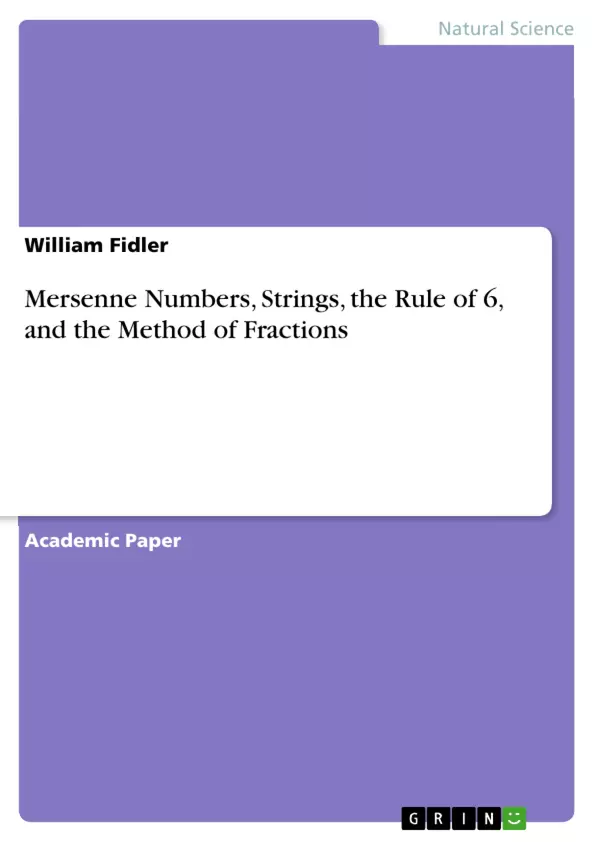The work developed here brings a significant measure of order to the search for prime numbers.
It is shown conclusively that no Mersenne number can have an integer square root, this being, until now, one of the unsolved problems in Number theory. It is shown that there are a new set of numbers given by F = (M + 2)/3 where M is a Mersenne number. it is found that when M is prime then F is prime. however, it is also found that prime numbers may be generated when M is composite and the index of the Mersenne number is prime, but this is not invariably the case.
An accelerated method of trial division is derived and from which we construct one row matrices which we have called, templates. These are found to be of great utility in determining factors of numbers, and their 'extent' is equal to the number of digits in a number of interest. The template may be easily extended by a simple process explained in the text. Extension of a template by one unit increases that range of numbers which may be examined by an order of magnitude.
Inhaltsverzeichnis (Table of Contents)
- Introduction
- Analysis
- The Magic Matrix
- Primary Strings and the Rule of 6
- The Method of Fractions
- Templates
- Mersenne numbers
- Discussion
- References
Zielsetzung und Themenschwerpunkte (Objectives and Key Themes)
This work seeks to bring order to the search for prime numbers, specifically focusing on Mersenne numbers. It utilizes the concept of primary strings and a novel "Rule of 6" for analyzing the location and characteristics of prime numbers within these strings.
- Exploring the relationship between Mersenne numbers and prime numbers
- Developing a systematic method for identifying prime numbers within primary strings
- Analyzing the properties and characteristics of Mersenne numbers
- Introducing the "Method of Fractions" for accelerated trial division
- Demonstrating the application of the "Magic Matrix" in prime number analysis
Zusammenfassung der Kapitel (Chapter Summaries)
- Introduction: This chapter provides context for the study of prime numbers, particularly Mersenne numbers, highlighting their historical significance and contemporary relevance in cryptography and the search for large primes.
- Analysis: This section delves into the properties of prime numbers, introducing the "Magic Matrix" and its role in locating prime numbers. It also discusses the construction of primary strings and the "Rule of 6" for determining the location of prime numbers within these strings.
- The Magic Matrix: This chapter explores the construction and application of the "Magic Matrix," demonstrating how it simplifies the analysis of prime numbers and provides a framework for understanding their distribution.
- Primary Strings and the Rule of 6: This chapter focuses on the properties of primary strings and the development of the "Rule of 6," a method for determining the location and characteristics of prime numbers within these strings.
- The Method of Fractions: This chapter introduces the "Method of Fractions," an accelerated trial division technique that utilizes templates to efficiently analyze large numbers for prime factors.
- Templates: This section explores the construction and application of templates within the "Method of Fractions," demonstrating their role in identifying prime factors and extending the range of numbers that can be analyzed.
- Mersenne numbers: This chapter delves into the specific analysis of Mersenne numbers, examining their characteristic signatures and their relationship to prime numbers. It also explores a formula for generating prime numbers from Mersenne numbers.
Schlüsselwörter (Keywords)
The key concepts and topics explored in this work include: prime numbers, Mersenne numbers, primary strings, the "Rule of 6," the "Method of Fractions," templates, characteristic signatures, and the "Magic Matrix." The work provides a systematic approach to understanding the properties and distribution of prime numbers, particularly within the context of Mersenne numbers, and offers practical tools for analyzing and identifying these numbers.
- Quote paper
- William Fidler (Author), 2023, Mersenne Numbers, Strings, the Rule of 6, and the Method of Fractions, Munich, GRIN Verlag, https://www.hausarbeiten.de/document/1389654


